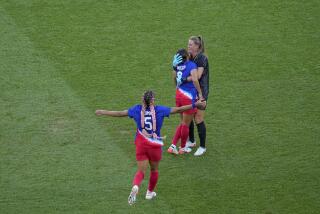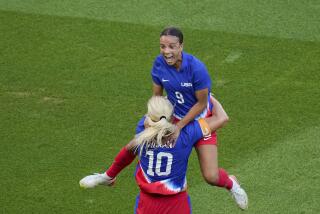SUCCESS OF THE ’99 WOMENS’ WORLD CUP IS ... LOOKING GOOD
It began with a woman named Brandi and her soccer ball. Nothing more, and, from the standpoint of traditional uniforming, quite a bit less.
There was Brandi Chastain, starting defender for the U.S. Women’s World Cup team, captured in a full-page photo in Gear magazine looking as if some wiseacre teammate had just thrown her a ball as she stepped out of the locker room shower.
No shorts. No jersey. No shinguards. Just Chastain cradling a strategically placed soccer ball, giving the shirt off her back, so to speak, for the promotion of the Women’s World Cup.
As public-relations gambits go, it was less than daringly original. The U.S. men’s Olympic water polo team struck similar poses in an attempt to drum up some publicity before the 1996 Summer Games. It created barely a ripple, possibly because no sports-drink company choreographed a blanket ad campaign featuring guys in funny headgear going five-on-one against Michael Jordan.
And possibly because David Letterman never got worked up over it.
Once Chastain’s provocative pose as fullback-in-the-buff caught Letterman’s attention, the dominoes fell in a flurry. Before she knew it, Chastain was sitting on the “Late Show” set, bantering good-naturedly with a seemingly smitten Letterman, who could no longer bottle his enthusiasm for Chastain and her U.S. soccer teammates.
“The U.S. team--and this may come out wrong; I’ll just say it now and forget about it--is Babe City, ladies and gentlemen. Babe City!” Letterman declared, and a team had been christened, whether any of the players liked it or not.
The tag has followed Team USA across the country and through the late stages of the tournament, like an annoying autograph hound who just won’t go away. It is still there, hovering over the team as it prepares to play China in Saturday’s World Cup final at the Rose Bowl, spawning a line of questioning from the burgeoning media bandwagon not often heard at a Super Bowl or the NBA finals.
“If you were all ugly, if you were not wholesome, attractive, whatever--words that have been attached to you--would this team be as popular?” Chastain was asked after practice the other day.
Somewhat surprisingly, the questioner wasn’t cursed or insulted, Chastain didn’t stomp away amid a stream of expletives and the player actually hung in there long enough to make a sober, rational response--but, then, that’s another difference between the U.S. women’s soccer team and, say, the New York Knicks.
“I’m not really good at predicting scores or predicting behavior or feelings or beliefs,” Chastain said. “I think people are attracted to this team for different reasons. Let me just say that.
“There are those people who come purely for the soccer. There are those people who come purely for the event. And there are those people who come because they like us, to look at us.
“Those are three great reasons to come. I don’t think I need to go any further than that.”
Because a nation has unexpectedly swooned over a group of suntanned, ponytailed, athletic women in cleats, commentators are left to grapple for the deep explanations why. Certainly, Team USA’s popularity with young girls looking for positive role models is an easy concept to understand. So, too, with women basking in the moment, this rarest of months when a group of soccer-playing females knocked Wimbledon to the bottom of the front page of the sports section and bumped coverage of major league baseball--the national pastime!--to the inside pages.
But why are boys wearing Mia Hamm jerseys and painting their faces red, white and blue?
Why are men lining up to buy tickets and keeping the big-screen TV tuned to USA-Brazil on the Fourth of July?
It can’t be just for the soccer, can it?
Or for Julie Foudy’s wit or Michelle Akers’ resolve or Briana Scurry’s calm self-assurance in between the pipes?
No, there must be other Reasons Why, with much analysis turning musical, if not lyrical:
The girls might be twisting and shouting to the Beatles of female soccer, but the men are there to ogle the Babe City Rollers, right?
Asked about this line of reasoning, Foudy, the quick-quipping midfielder, shakes her head and almost winces.
“It makes me laugh,” Foudy says. “It makes me think, ‘God, aren’t we beyond that?’
“But I’ve been getting that question a lot. If you ask the 70,000 people who came [to the USA-Brazil semifinal], I don’t think you’re going to hear, ‘Oh, that Tisha Venturini is one hot babe.’
“They came to see some awesome soccer. Because they love the sport. And because we win. That’s always a great attraction.”
Chastain maintains, “There’s not one definition of what is [feminine] and what it beautiful and what is athletic. And there will never be one definition and there will never be one answer to that question because everybody has their own opinion, their own perspective.
“So all I can do for my teammates and for myself is to get the message out that we are athletic and that we are women and that we are beautiful. See us for what we are and not for anything else besides that.”
Babe City isn’t likely to shut down any time soon, however, not in a culture where Anna Kournikova, winner of zero tournaments on the women’s professional tennis tour, is more famous and on more magazine covers than the reigning women’s No. 1, Lindsay Davenport.
Aaron Heifetz, press officer for the U.S. women’s soccer team, concedes that sex appeal has “no doubt played a factor” in Team USA’s popularity.
“We don’t want to sell our sport on sex,” Heifetz says, “but their being attractive is a nice offshoot. What’s the line--’Don’t hate me because I’m beautiful’?
“They are modern women. They can do it all. They can have it all.”
Heifetz mulls that over for a moment.
“Well,” he adds with a grin, “they will if they beat China.”
FINAL
Saturday at Rose Bowl
UNITED STATES vs. CHINA
12:45 p.m., Ch. 7
THIRD PLACE
BRAZIL vs. NORWAY
10:15 a.m., ESPN






